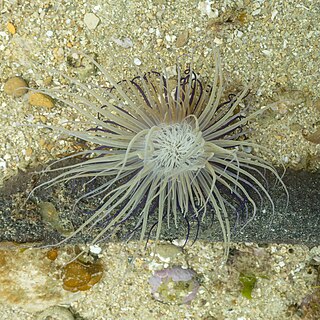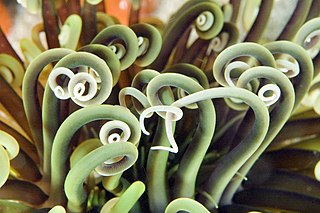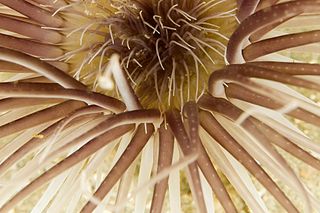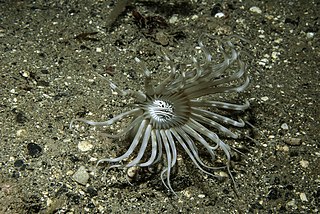
Anemone is a genus of flowering plants in the buttercup family Ranunculaceae. Plants of the genus are commonly called windflowers. They are native to the temperate and subtropical regions of all continents except Australia, New Zealand and Antarctica. The genus is closely related to several other genera including Anemonoides, Anemonastrum, Hepatica, and Pulsatilla. Some botanists include these genera within Anemone.

The genus Pulsatilla contains about 40 species of herbaceous perennial plants native to meadows and prairies of North America, Europe, and Asia. Derived from the Hebrew word for Passover, "pasakh", the common name pasque flower refers to the Easter (Passover) flowering period, in the spring. Common names include pasque flower, wind flower, prairie crocus, Easter flower, and meadow anemone. Several species are valued ornamentals because of their finely-dissected leaves, solitary bell-shaped flowers, and plumed seed heads. The showy part of the flower consists of sepals, not petals.

Tube-dwelling anemones or ceriantharians look very similar to sea anemones but belong to an entirely different class of anthozoans. They are solitary, living buried in soft sediments. Tube anemones live inside and can withdraw into tubes, which are composed of a fibrous material made from secreted mucus and threads of nematocyst-like organelles known as ptychocysts. Within the tubes of these ceriantharians, more than one polyp is present, which is an exceptional trait because species that create tube systems usually contain only one polyp per tube. Ceriantharians were formerly classified in the taxon Ceriantipatharia along with the black corals but have since been moved to their own class, Ceriantharia.

Pachycerianthus fimbriatus is a cerianthid anemone that burrows in substrate and lives in a semi-rigid tube made of felted nematocysts. The anemone is often seen in bright orange to red.

Sea anemones are a group of predatory marine invertebrates constituting the order Actiniaria. Because of their colourful appearance, they are named after the Anemone, a terrestrial flowering plant. Sea anemones are classified in the phylum Cnidaria, class Anthozoa, subclass Hexacorallia. As cnidarians, sea anemones are related to corals, jellyfish, tube-dwelling anemones, and Hydra. Unlike jellyfish, sea anemones do not have a medusa stage in their life cycle.

Phymanthus crucifer, commonly known as rock flower anemone, flower anemone, red beaded anemone or the beaded anemone, is a species of sea anemone in the family Phymanthidae. It has been described as "closely similar" to Heteractis aurora in several ways, commonly exhibiting "tentacles with swollen cross-bars" bearing large clusters of stinging nematocysts. However, P. crucifer may also be found with smooth tentacles, sometimes in the immediate vicinity of a swollen-crossbarred specimen.

The walking anemone, also known as the hedgehog anemone or sock anemone, is a species of sea anemones in the order Actiniaria. It is the only member of its genus, Preactis.

Cerianthus is a genus of tube-dwelling anemones in the family Cerianthidae. Members of the genus are found worldwide. They are predators, scavengers and omnivores.

The burrowing anemone is a species of tube-dwelling anemone in the family Cerianthidae.

Anemonia is a genus of sea anemones belonging to the family Actiniidae.

Cerianthus membranaceus, the cylinder anemone or coloured tube anemone, is a species of large, tube-dwelling anemone in the family Cerianthidae. It is native to the Mediterranean Sea and adjoining parts of the northeastern Atlantic Ocean.

Cerianthidae is a family of tube-dwelling anemones in the order Spirularia of the subclass Ceriantharia.
Ceriantheomorphe is a genus of tube-dwelling anemones in the family Cerianthidae.

Ceriantheomorphe brasiliensis is a species of tube-dwelling anemones in the family Cerianthidae. It is found in the tropical western Atlantic Ocean, the Caribbean Sea and the Gulf of Mexico. It is currently listed as endangered based on a lack of evidence.

Ceriantheopsis americana is a species of tube-dwelling anemone in the family Cerianthidae. It is a burrowing species and lives in deep sand or muddy sand in a long slender tube that it creates.

Arachnactidae is a family of tube-dwelling anemones in the order Ceriantharia. It is the only family in the monotypic order Penicillaria and comprises around 38 species. They differ from other ceriantharians in the makeup of their cnidome, the relative sizes of the oral discs and the shape and structure of the mesenteries. These tube anemones dwell in parchment-like tubes immersed in soft sediment, and have two whorls of tentacles, the outer ones being much longer than the inner ones.

Arachnanthus is a genus of tube-dwelling anemones in the family Arachnactidae. Members of the genus are found worldwide.

Pachycerianthus is a genus of marine tube-dwelling anemones in the family Cerianthidae.

Leiopathes is a genus of hexacorallians belonging to the anthozoan clade Antipatharia. It is the only genus in the Leiopathidae family. The genus name means "smooth disease".
Bathypathes is a genus of black coral in the family Schizopathidae.


















